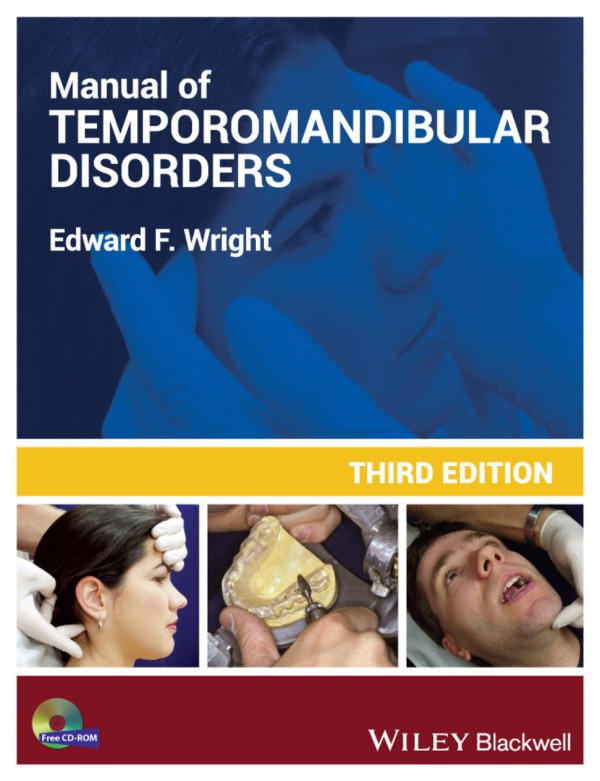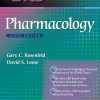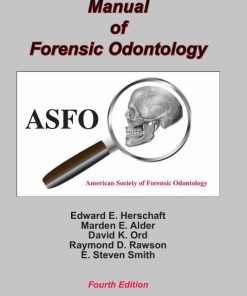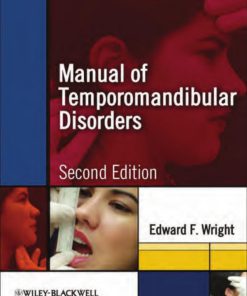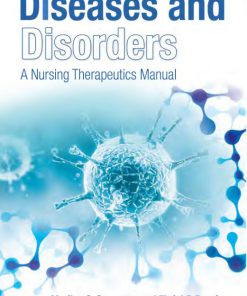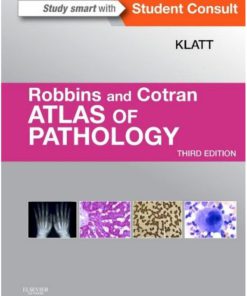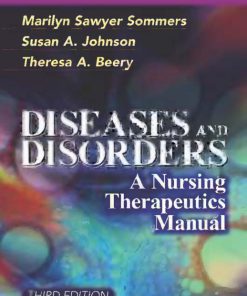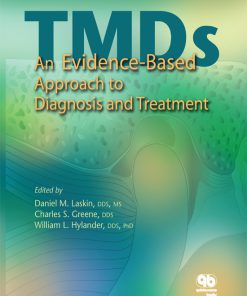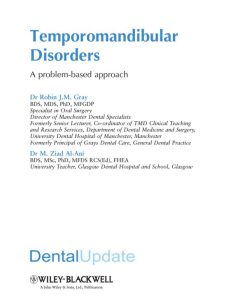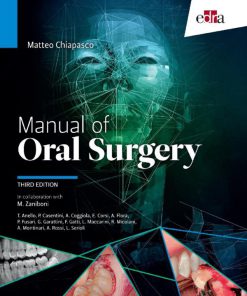Manual of Temporomandibular Disorders 3rd Edition by Edward Wright 9781118502693 1118502698
$50.00 Original price was: $50.00.$25.00Current price is: $25.00.
Authors:Wright, Edward F. , Author sort:Wright, Edward F. , Published:Published:Dec 2013
Manual of Temporomandibular Disorders 3rd Edition by Edward Wright- Ebook PDF Instant Download/Delivery.9781118502693,1118502698
Full download Manual of Temporomandibular Disorders 3rd Edition after payment
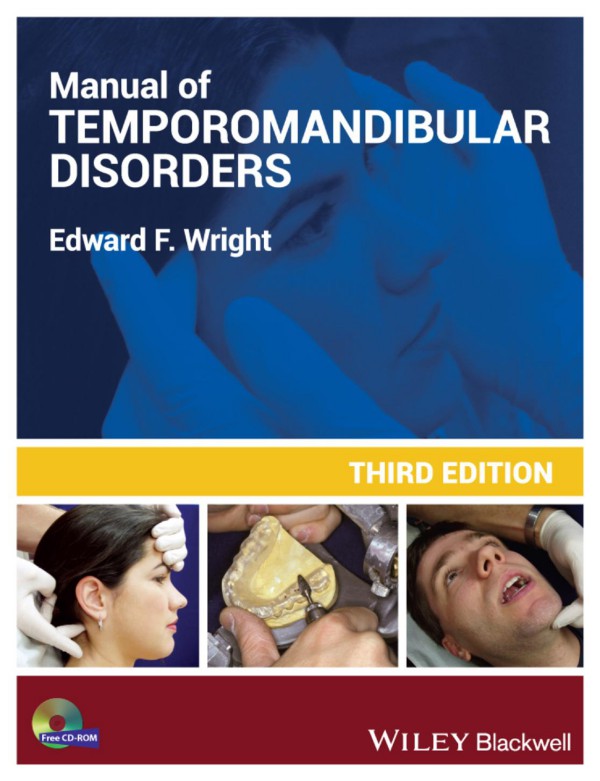
Product details:
ISBN 10:1118502698
ISBN 13:9781118502693
Author: Edward Wright
Manual of Temporomandibular Disorders, Third Edition, provides comprehensive, evidence-based information on temporomandibular disorders (TMD). Focusing on clinically relevant information throughout, the book allows dentists to diagnose TMD accurately, rule out disorders that mimic TMD, and provide effective therapy for most patients.
Useful features, such as frequently asked questions, quick consults, technical tips, and focal points are integrated to help the clinician find precise answers with ease. Case scenarios provide the reader with a way to enhance their clinical reasoning skills, with a focus on solving TMD problems at chairside.
Offering comprehensive coverage in a highly-illustrated, compact package, Manual of Temporomandibular Disorders is the ideal source for dentists dealing patients suffering from TMD.
Manual of Temporomandibular Disorders 3rd Table of contents:
Part I Initial Evaluation
FOCAL POINT
FOCAL POINT
FOCAL POINT
FOCAL POINT
Chapter 1 Patient Interview
FAQs
QUICK CONSULT
QUICK CONSULT
TECHNICAL TIP
FOCAL POINT
QUICK CONSULT
QUICK CONSULT
QUICK CONSUL
Chapter 2 Review of the “Initial Patient Questionnaire”
Chapter 3 Clinical Examination
FAQs
QUICK CONSULT
QUICK CONSULT
Range of Motion
Figure 3.1. Measuring the opening incisal edge to incisal edge.
TECHNICAL TIP
Figure 3.2. Measuring the vertical overlap of the central incisors.
TECHNICAL TIP
Figure 3.3. Measuring lateral movement.
TECHNICAL TIP
Figure 3.4. Measuring the distance the mandibular incisors are in front of the maxillary incisors.
TECHNICAL TIP
TMJ Noise
Intraoral Examination
Occlusal Changes
Figure 3.27. Patient holding shim stock between tooth 4 and its opposing tooth. This technique is used to determine which maxillary teeth have sufficiently close contacts enabling shim stock to be held.
QUICK CONSULT
TMD Pain Caused by a Tooth
QUICK CONSULT
Table 3.3. Stabilization appliance alternatives for TMD patients who need multiple restorations.
FOCAL POINT
FOCAL POINT
QUICK CONSULT
Tooth Pain without Local Pathology
FOCAL POINT
Figure 3.28. A depiction of central convergence enabling masseter muscle pain to be perceived as tooth pulp pain.
Figure 3.29. Radiograph of a TMD patient who perceived her TMD pain to be of pulpal origin and convinced dentists to treat her pain with endodontic therapy.
QUICK CONSULT
Additional Evaluations
Table 3.4. Patient characteristics for which most general dentists would refer to a practitioner with greater expertise.
QUICK CONSULT
References
Chapter 4 Imaging
QUICK CONSULT
FOCAL POINT
Plain Radiographs
Panoramic Radiograph
QUICK CONSULT
References
Chapter 5 TMD Diagnostic Categories
FAQ
QUICK CONSULT
Table 5.1. TMD Diagnostic Categories and Diagnoses
TMJ Disorders
Joint Pain
Arthralgia
Arthritis
Joint Disorders
Chapter 6 Contributing Factors
FAQ
FOCAL POINT
Table 6.1. Events that patients related to TMD onset (n = 230).
QUICK CONSULT
FOCAL POINT
QUICK CONSULT
QUICK CONSULT
QUICK CONSULT
FOCAL POINT
QUICK CONSULT
TECHNICAL TIP
References
Part II Common Acute TMD Conditions and Treatments
FOCAL POINT
Chapter 7 TMD Secondary to Trauma
FAQ
QUICK CONSULT
QUICK CONSULT
FOCAL POINT
QUICK CONSULT
QUICK CONSULT
TECHNICAL TIP
QUICK CONSULT
FOCAL POINT
TECHNICAL TIP
References
Chapter 8 TMD Secondary to Dental Treatment
FAQs
QUICK CONSULT
FOCAL POINT
Table 8.1. Cursory TMD evaluation palpations for dental patients.
QUICK CONSULT
Table 8.2. Postoperative causes for TMD symptoms.
Preventing Aggravation from Dental Treatment
TECHNICAL TIP
TECHNICAL TIP
Medial Pterygoid Muscle Pain
Figure 8.1. Stretching exercise recommended for a masticatory closure muscle spasm, contracture, or a TMJ disc displacement without reduction with limited opening. This exercise is recommended rather than the “Closure Muscle-Stretching Exercise” in Appendix 6, because these conditions require more forceful stretching, which may cause the digastric muscles to become painful.
TECHNICAL TIP
Figure 8.2. Forceful stretching procedure that may be desired for a resistant medial pterygoid spasm, contracture, or fibrous ankylosis.
QUICK CONSULT
Inability to Close into Maximum Intercuspation
TECHNICAL TIP
TECHNICAL TIP
TECHNICAL TIP
Table 8.3. Preventing TMD aggravation from dental treatment.
QUICK CONSULT
QUICK CONSULT
Occlusal Interference Sequelae
QUICK CONSULT
QUICK CONSULT
QUICK CONSULT
Obstructive Sleep Apnea Appliances
Figure 8.3. Change over time in the percentage of subjects wearing an obstructive sleep apnea appliance who had TMD pain.19
FOCAL POINT
References
Chapter 9 Lateral Pterygoid Spasm
QUICK CONSULT
Figure 9.1. Lateral pterygoid spasm often causes a gap between the ipsilateral posterior teeth.
TECHNICAL TIP
Figure 9.2. Stretching lateral pterygoid muscle.
TECHNICAL TIP
QUICK CONSULT
QUICK CONSULT
References
Chapter 10 Intermittent and Continuous Forms of TMJ Disc Displacement without Reduction with Limited Opening
FAQ
QUICK CONSULT
QUICK CONSULT
FOCAL POINT
FOCAL POINT
QUICK CONSULT
QUICK CONSULT
References
Chapter 11 TMJ Subluxation and Luxation
QUICK CONSULT
QUICK CONSULT
QUICK CONSULT
Figure 11.1. Patient unlocked a TMJ luxation by resting his chin in his hand, concentrating on relaxing his closure muscles, allowing the weight of his head to place an upward force on his chin, distracting the condyles, and then gently retruding his mandible. The Monoject syringe barrel was placed over the occlusal plane, as posterior as the patient could tolerate, and acted as a fulcrum to enable the upward force to distract the condyles.
TECHNICAL TIP
References
Part III Occlusal Appliance Therapy
FOCAL POINT
QUICK CONSULT
FOCAL POINT
QUICK CONSULT
FOCAL POINT
Chapter 12 Stabilization Appliance
FAQs
FOCAL POINT
FOCAL POINT
Mandibular Positions and Interocclusal Record
QUICK CONSULT
References
Chapter 13 Anterior Positioning Appliance
FAQ
Figure 13.1. Condyle in the reduced position.
FOCAL POINT
FOCAL POINT
Mandibular Position and Interocclusal Record
Design and Adjustments
Chapter 14 Self-Management Therapy
FAQs
QUICK CONSULT
QUICK CONSULT
Self-Management Instructions
TECHNICAL TIP
TECHNICAL TIP
TECHNICAL TIP
Figure 14.1. A higher percentage of TMD patients related that they did not need any additional therapy following sequential use of a moist heating pad compared with moist hot towels.15
Figure 14.2. Correlation with caffeine consumption (100 mg of caffeine is in one standard brewed cup of coffee) and headache prevalence.21
Chapter 15 Physical Medicine
QUICK CONSULT
FOCAL POINT
Muscle Massage
QUICK CONSULT
Yoga
Trigger-Point Compression
Trigger-Point Injection
QUICK CONSULT
Physical Therapy
FOCAL POINT
Table 15.1. Recommendations for when to consider referring a patient to a physical therapist.
Figure 15.1. Demonstrates the clinically significant long-term effect a single cervical exercise can have on cervicogenic headaches.36
QUICK CONSULT
Acupuncture
Figure 15.2. Initially, acupuncture was more effective than appliance therapy, but over time, acupuncture lost its effectiveness and appliance therapy was superior.
FOCAL POINT
Chiropractics
QUICK CONSULT
Magnetic Therapy
References
Chapter 16 Cognitive-Behavioral Intervention
FAQs
FOCAL POINTS
QUICK CONSULT
Chapter 17 Pharmacological Management
FAQs
FOCAL POINT
QUICK CONSULTS
Analgesics
Anti-Inflammatory Medications
QUICK CONSULT
Chapter 18 Other Dental Procedures
FAQs
FOCAL POINT
FOCAL POINT
QUICK CONSULT
FOCAL POINT
QUICK CONSULT
Occlusal Equilibration
Figure 18.1. Partial equilibration only provided slightly better symptom improvement than mock equilibration and caused some individuals’ symptoms to worsen.24
Figure 18.2. Stabilization appliances in conjunction with home exercises were more beneficial for TMD symptoms than 4-hour equilibrations.15
QUICK CONSULT
Orthodontic–Orthognathic Therapy
FOCAL POINT
Prosthodontic Therapy
QUICK CONSULT
TECHNICAL TIP
TMJ Surgery and Implants
FOCAL POINT
References
Chapter 19 Integrating Multidisciplinary Therapies
FAQ
FOCAL POINT
Treatment Summaries and Clinical Implications
Self-Management Therapy
TECHNICAL TIP
Massage and Trigger-Point Compression
Lateral Pterygoid Muscle-Stretching Exercise
Closure Muscle-Stretching Exercise
Posture Exercises
Occlusal Appliances
QUICK CONSULT
Part VI Fundamentals of Clinical Studies
Designs of and Advice for Performing Clinical Studies
QUICK CONSULT
Literature Review
FOCAL POINT
Study Population
Institutional Review Board (IRB) Approval
TECHNICAL TIP
Developing Study’s Parameters
TECHNICAL TIP
Strengthening Your Study
Writing and Submitting Manuscript
FOCAL POINT
Practice-Based Research
Prominent Clinical Study Designs
FOCAL POINT
Case Report
FOCAL POINT
Case Series Study
Figure VI.1. The time period over which the various studies evaluate their findings.
TECHNICAL TIP
Cross-Sectional Study
Case-Control Study
Cohort Study
Nonrandomized Clinical Trial
TECHNICAL TIP
TECHNICAL TIP
FOCAL POINT
Randomized Controlled Trial
Parallel-Group Randomized Clinical Trial
Cross-Over Randomized Clinical Trials
Other Types of Publications You May Want to Consider
Literature Reviews
FOCAL POINT
Systematic Reviews
FOCAL POINT
Meta-Analyses
Considerations in Assessing Clinical Trials
Conclusions
References
People also search for Manual of Temporomandibular Disorders 3rd :
temporomandibular joint dysfunction how long does it last
management of temporomandibular disorders and occlusion 8th edition
temporomandibular joint manual therapy
temporomandibular joint dysfunction how long does it last
diagnostic criteria for temporomandibular disorders (dc/tmd)
You may also like…
eBook PDF
Manual of Temporomandibular Disorders 2nd Edition by Edward Wright 0813813247 9780813813240
eBook PDF
Robbins and Cotran Atlas of Pathology 3rd Edition by Edward Klatt ISBN 1455748765 9781455748761

